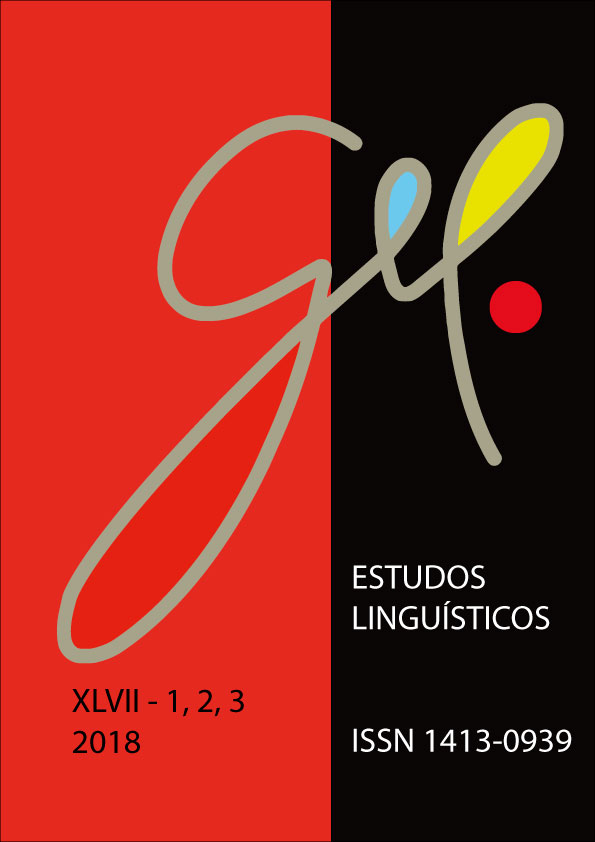Telegrams and ‘telegraghic speech’
DOI:
https://doi.org/10.21165/el.v47i2.1936Keywords:
agrammatism, telegrams, reduced styleAbstract
The aim of this study is to replicate an experiment with telegrams proposed by Tesak e Dittmann (1991) thus proving that telegrams are organized according to different rules than the ones observed in the speech of agrammatic subjects. 70 telegrams were contrasted with 76 incomplete utterances produced by one agrammatic subject in an informal conversation situation. The present study makes four major distinctions between telegrams and agrammatic speech: they differ in regard to (i) the reasons for the emergence of the telegraphic style and the agrammatic speech, (ii) the amount of linguistic material; (iii) verb finiteness and (iv) word order. Agrammatic speech is analysed here within the framework of Neurolinguistics from an enunciative-discoursive perspective and Adaptation Theory.Downloads
References
ABREU, A. S. Gramática mínima: para o domínio da língua padrão. Cotia: Ateliê Editorial, 2003.
BAKHTIN, M. O enunciado, a unidade da comunicação verbal. In: BAKHTIN, M. Estética da criação verbal. São Paulo: Martins Fontes, 1997. p. 289-327.
BELFORD, E. de M. Topicalização de objetos e deslocamento de sujeitos na fala carioca: um estudo sociolingüístico. 2006. 91 p. Dissertação (Mestrado em Linguística) – Faculdade de Letras, Universidade Federal do Rio de Janeiro, Rio de Janeiro, 2006.
COUDRY, M. I. H. Linguagem e afasia: uma abordagem discursiva da neurolinguística. Caderno de Estudos Linguísticos, v. 42, p. 99-130, 2002.
COUDRY, M. I. H. et al. (Orgs.). Caminhos da Neurolinguística Discursiva: teorização e práticas com a linguagem. Campinas: Mercado de Letras, 2010.
HAARMANN, H.; KOLK, H. A computer model of the temporal course of agrammatic sentence understanding: the effects of variation in severity and sentence complexity. Cognitive Science, v. 15, p. 49-87, 1991.
HEESCHEN, C.; KOLK, H. Adaptation bei Aphatischen Störungen. Zeitschrift für Literatur-wissenschaft und Linguistik, v. 18, n. 69, p. 41-54, 1988a.
HEESCHEN, C.; KOLK, H. Agrammatism and Paragrammatism. Aphasiology, v. 2, p. 299-302, 1988b.
HOFSTEDE, B. T. M. Agrammatic speech in Broca’s aphasia: strategic choice for the elliptical register. 1992. 121 f. Tese (Doutorado em Linguística) – Radboud Universiteit Nijmegen, Países Baixos, 1992.
JACOBS, J. The dimensions of topic-comment. Linguistics, v. 39, p. 641-681, 2001.
KLEPPA, L.-A. Estruturas de tópico-comentário na fala reduzida de um sujeito afásico. Revista Estudos Linguísticos, v. 43, n. 2, p. 926-939, 2014.
KOLK, H. A Time-Based Approach to Agrammatic Production. Brain and Language, v. 50, p. 282-303, 1995.
KOLK, H. Syntactic impairment is the bottle-neck to communication in nonfluent aphasia. Aphasiology, v. 15, p. 381-385, 2001a.
KOLK, H. Does agrammatic speech constitute a regression to child language? A three-way comparison between agrammatic, child and normal ellipsis. Brain and Language, v. 77, n. 3, p. 340-351, 2001b.
KOLK, H. How Language Adapts to the Brain: An Analysis of Agrammatic Aphasia. In: PROGOVAC, L.; PAESANI, K.; CASIELLES, E.; BARTON, E. (Orgs.). The Syntax of Nonsententials. Multidisciplinary perspectives. Linguistik Aktuell, v. 93, p. 29-258, 2006.
KOLK, H.; HEESCHEN, C. Review. Adaptation symptoms and impairment symptoms in Broca's aphasia. Aphasiology, v. 4, p. 221-231, 1990.
KOLK, H.; HEESCHEN, C. Agrammatism, Paragrammatism and the Management of Language. Language and Cognitive Processes, v. 7, n. 2, p. 89-129, 1992.
KOLK, H.; HEILING, G.; KEYSER, A. Agrammatism in Dutch: Two Case Studies. In: MENN, L.; OBLER, L. (Orgs.). Agrammatic Aphasia: A Cross-language Narrative Sourcebook. John Benjamins Publishing Company: Amsterdam/ Philadelphia, 1990. p. 179-280.
KOLK, H.; VAN GRUNSVEN, M. J. F. Agrammatism as a variable phenomenon. Cognitive Neuropsychology, v. 2, p. 347-384, 1985.
MASLOVA, E.; BERNINI, G. Sentence topics in the languages of Europe and beyond. In: BERNINI, G.; SCHWARTZ, M. L. (Eds.). Pragmatic organization of discourse in the languages of Europe. Berlin, New York: Mouton de Gruyter, 2006. p. 67-120.
MORATO, E. M. (Org.). Sobre as afasias e os afásicos. Campinas: Editora da Unicamp, 2002.
MORATO, E. M. Introdução. In: MORATO, E. M. (Org.). A semiologia das afasias: perspectivas linguísticas. São Paulo: Cortez, 2010, p. 9-21.
NOVAES PINTO, R. do C. Agramatismo: uma contribuição para o estudo do processamento normal de linguagem. 1992. 173 f. Dissertação (Mestrado em Linguística) – Instituto de Estudos da Linguagem, Universidade Estadual de Campinas, Campinas, 1992.
NOVAES PINTO, R. do C. A adoção de conceitos bakhtinianos para a análise de linguagem de sujeitos afásicos. Lingua(gem), v. 1, n. 1, p. 111-147, 2004.
NOVAES PINTO, R. do C. Cérebro, linguagem e funcionamento cognitivo na perspectiva sócio-histórico-cultural: inferências a partir do estudo das afasias. Letras de Hoje, v. 47, n. 1, p. 55-64, 2012.
PERINI, M. A. Gramática Descritiva do Português. São Paulo: Ática, 1995.
PONTES, E. O tópico no português do Brasil. Campinas: Editora Pontes, 1987.
STARK, J. A.; DRESSLER, W. U. Agrammatism in German: Two Case Studies. In: MENN, L.; OBLER, L. (Eds.). Agrammatic Aphasia: A Cross-language Narrative Sourcebook. John Benjamins Publishing Company: Amsterdam/ Philadelphia, 1990. p. 281-442.
TESAK, J. Dutch telegraphese. Linguistics, v. 32, p. 325-344, 1994.
TESAK, J.; DITTMANN, J. Telegraphic style in normals and aphasics. Linguistics, v. 29, p. 1111-1137, 1991.
TESAK, J.; NIEMI, J. Telegraphese and agrammatism: a cross-linguistic study. Aphasiology, v. 11, p. 145-157, 1997.
VERSLUIS, C.; KLEPPA, L.-A. The use of interactive structures as communicative strategy in Dutch and Portuguese aphasic speakers. In: PASCUAL, E.; SANDLER, S. (Eds.). The conversation frame: forms and functions of fictive interaction. Amsterdam/Philadelphia: John Benjamins Publishing Company, 2016. p. 323-342.



